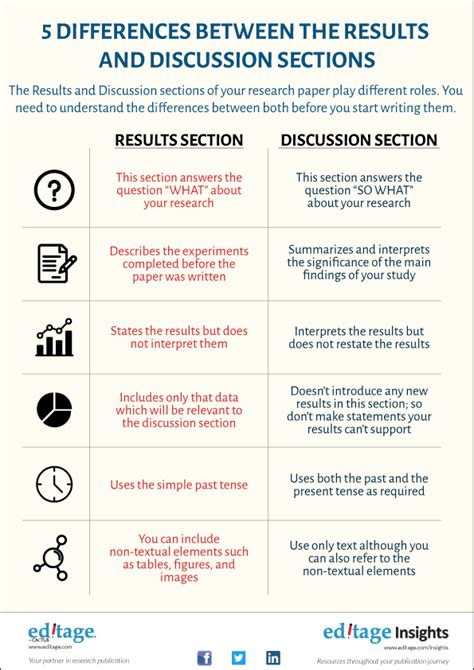results and discussions|result discussion conclusion : Tagatay Start this section by reiterating your research problem and concisely summarizing your major findings. To speed up the process you can use a summarizer to quickly get an overview of all important findings. Don’t just repeat all the data . Tingnan ang higit pa This theme was developed by

results and discussions,Learn how to write a discussion section for your research paper or dissertation. Find out what to include, what to avoid, and see examples of different approaches. Tingnan ang higit pa
results and discussions result discussion conclusionThere are a few common mistakes to avoid when writing the discussion section of your paper. 1. Don’t introduce new results: You should only discuss the data that you . Tingnan ang higit paStart this section by reiterating your research problem and concisely summarizing your major findings. To speed up the process you can use a summarizer to quickly get an overview of all important findings. Don’t just repeat all the data . Tingnan ang higit paAs well as giving your own interpretations, make sure to relate your results back to the scholarly work that you surveyed in the literature review. The discussion should show how . Tingnan ang higit paresult discussion conclusionThe meaning of your results may seem obvious to you, but it’s important to spell out their significance for your reader, showing exactly how they answer your research question. The form of your interpretations will depend on the type of research, . Tingnan ang higit paThe results section of your research paper contains a description about the main findings of your research, whereas the discussion section interprets the results for readers and provides the significance of the . Learn how to report the main findings of your data collection and analysis in a concise and objective way. Find out the best practices for quantitative and qualitative research results, and the .Learn how to write effective discussions and conclusions for your research papers. Find tips, questions, structure, examples and common mistakes to avoid. Discussion section: what is it, what it does. The discussion section comes later in your paper, following the introduction, methods, and results. The discussion sets up your study’s conclusions. Its main . Unlike the results section, the discussion section is where you interpret your results and explain what they mean, draw implications from your results and articulate .Learn how to interpret and explain your results in your thesis or dissertation with examples and tips. The discussion chapter is where you evaluate your findings, situate them in . Discussion is mainly the section in a research paper that makes the readers understand the exact meaning of the results achieved in a study by exploring the significant points of the research,. Discussion Section. Author. Kakoli Majumder. Senior Editor, Editage Insights. Researcher coach since 2015. See more from Kakoli Majumder. This article discusses the tips and tricks of writing .Learn the difference between results and discussion in quantitative and qualitative research. Results report what you found, while discussion interprets and explains the .
The discussion section provides an analysis and interpretation of the findings, compares them with previous studies, identifies limitations, and suggests future directions for research. This . 今日分享: 本期内容主要介绍下Results & Discussion写作中的一个基本原则:先摆现象,讨论完了才能给出结论。什么意思呢?在SCI论文写作时,一般采用分总式,即先将实验结果列出来,然后结合文献等进行讨论,最后得出结论。结论的得出要基于实验结果和讨论。说起来好像全世界人民都知道一样 .
The Results section is one of the most critical parts of your research paper. Here you present the main results of your research to your readers. The Discussion section interprets the results presented in the paper. In other words, although it contains the introduction, methods, and results, you must also clarify the results for your audience. | . Keep in mind the following points while writing your discussion: Address the problem stated in your introduction. Review your findings in the context of supporting literature and existing knowledge. Critically analyze your results. Include future research directions in your discussion. Avoid repeating information given in the introduction.Next, the results section needs to communicate the findings of your research in a systematic manner. The section needs to be organized such that the primary research question is addressed first, then the secondary research questions. If the research addresses multiple questions, the results section must individually connect with each of .
Results/Findings. The Results (or Findings) section follows the Methods and precedes the Discussion section. This is where the authors provide the data collected during their study. That data can sometimes be difficult to understand because it is often quite technical. Do not let this intimidate you; you will discover the significance of the .

Research Results. Research results refer to the findings and conclusions derived from a systematic investigation or study conducted to answer a specific question or hypothesis. These results are typically presented in a written report or paper and can include various forms of data such as numerical data, qualitative data, statistics, charts, .
Research Results. Research results refer to the findings and conclusions derived from a systematic investigation or study conducted to answer a specific question or hypothesis. These results are typically presented in a written report or paper and can include various forms of data such as numerical data, qualitative data, statistics, charts, .results and discussionsStep 4: Acknowledge the limitations of your study. The fourth step in writing up your discussion chapter is to acknowledge the limitations of the study. These limitations can cover any part of your study, from the scope or theoretical basis .
results and discussions|result discussion conclusion
PH0 · sci results and discussion
PH1 · result discussion conclusion
PH2 · Iba pa